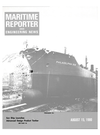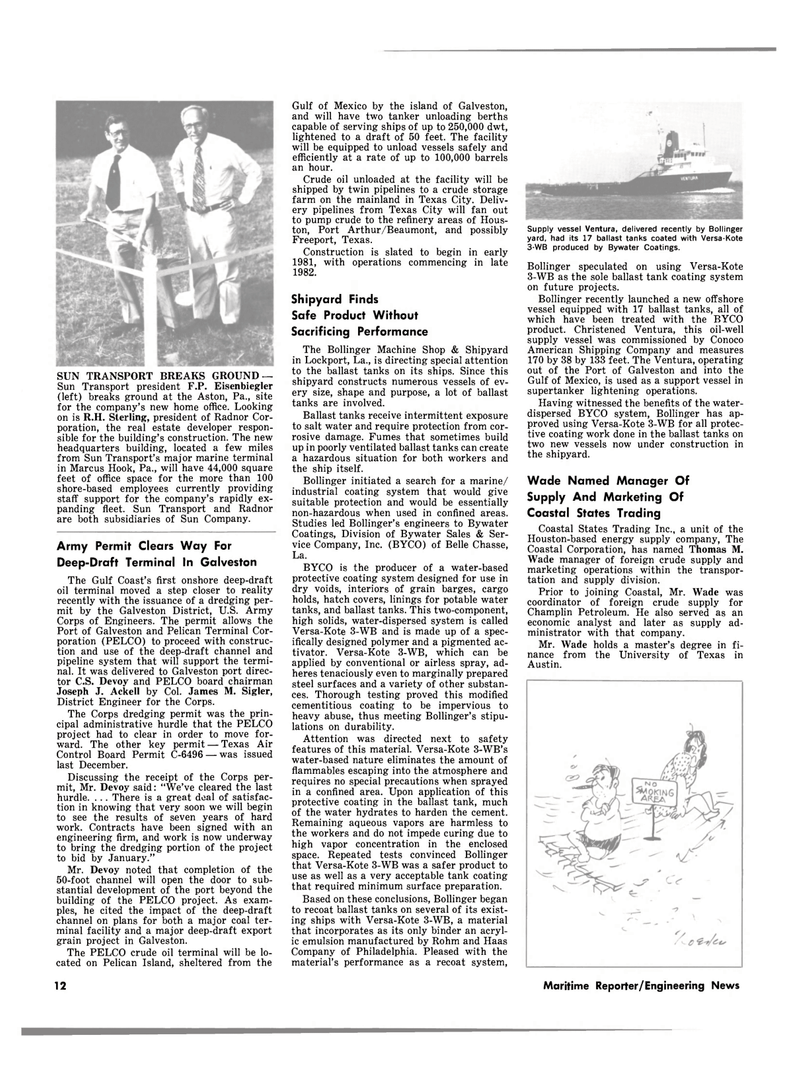
Page 10: of Maritime Reporter Magazine (August 15, 1980)
Read this page in Pdf, Flash or Html5 edition of August 15, 1980 Maritime Reporter Magazine
SUN TRANSPORT BREAKS GROUND —
Sun Transport president F.P. Eisenbiegler (left) breaks ground at the Aston, Pa., site for the company's new home office. Looking on is R.H. Sterling, president of Radnor Cor- poration, the real estate developer respon- sible for the building's construction. The new headquarters building, located a few miles from Sun Transport's major marine terminal in Marcus Hook, Pa., will have 44,000 square feet of office space for the more than 100 shore-based employees currently providing staff support for the company's rapidly ex- panding fleet. Sun Transport and Radnor are both subsidiaries of Sun Company.
Army Permit Clears Way For
Deep-Draft Terminal In Galveston
The Gulf Coast's first onshore deep-draft oil terminal moved a step closer to reality recently with the issuance of a dredging per- mit by the Galveston District, U.S. Army
Corps of Engineers. The permit allows the
Port of Galveston and Pelican Terminal Cor- poration (PELCO) to proceed with construc- tion and use of the deep-draft channel and pipeline system that will support the termi- nal. It was delivered to Galveston port direc- tor C.S. Devoy and PELCO board chairman
Joseph J. Ackell by Col. James M. Sigler,
District Engineer for the Corps.
The Corps dredging permit was the prin- cipal administrative hurdle that the PELCO project had to clear in order to move for- ward. The other key permit — Texas Air
Control Board Permit C-6496 — was issued last December.
Discussing the receipt of the Corps per- mit, Mr. Devoy said: "We've cleared the last hurdle. . . . There is a great deal of satisfac- tion in knowing that very soon we will begin to see the results of seven years of hard work. Contracts have been signed with an engineering firm, and work is now underway to bring the dredging portion of the project to bid by January."
Mr. Devoy noted that completion of the 50-foot channel will open the door to sub- stantial development of the port beyond the building of the PELCO project. As exam- ples, he cited the impact of the deep-draft channel on plans for both a major coal ter- minal facility and a major deep-draft export grain project in Galveston.
The PELCO crude oil terminal will be lo- cated on Pelican Island, sheltered from the
Gulf of Mexico by the island of Galveston, and will have two tanker unloading berths capable of serving ships of up to 250,000 dwt, lightened to a draft of 50 feet. The facility will be equipped to unload vessels safely and efficiently at a rate of up to 100,000 barrels an hour.
Crude oil unloaded at the facility will be shipped by twin pipelines to a crude storage farm on the mainland in Texas City. Deliv- ery pipelines from Texas City will fan out to pump crude to the refinery areas of Hous- ton, Port Arthur/Beaumont, and possibly
Freeport, Texas.
Construction is slated to begin in early 1981, with operations commencing in late 1982.
Shipyard Finds
Safe Product Without
Sacrificing Performance
The Bollinger Machine Shop & Shipyard in Lockport, La., is directing special attention to the ballast tanks on its ships. Since this shipyard constructs numerous vessels of ev- ery size, shape and purpose, a lot of ballast tanks are involved.
Ballast tanks receive intermittent exposure to salt water and require protection from cor- rosive damage. Fumes that sometimes build up in poorly ventilated ballast tanks can create a hazardous situation for both workers and the ship itself.
Bollinger initiated a search for a marine/ industrial coating system that would give suitable protection and would be essentially non-hazardous when used in confined areas.
Studies led Bollinger's engineers to Bywater
Coatings, Division of Bywater Sales & Ser- vice Company, Inc. (BYCO) of Belle Chasse,
La.
BYCO is the producer of a water-based protective coating system designed for use in dry voids, interiors of grain barges, cargo holds, hatch covers, linings for potable water tanks, and ballast tanks. This two-component, high solids, water-dispersed system is called
Versa-Kote 3-WB and is made up of a spec- ifically designed polymer and a pigmented ac- tivator. Versa-Kote 3-WB, which can be applied by conventional or airless spray, ad- heres tenaciously even to marginally prepared steel surfaces and a variety of other substan- ces. Thorough testing proved this modified cementitious coating to be impervious to heavy abuse, thus meeting Bollinger's stipu- lations on durability.
Attention was directed next to safety features of this material. Versa-Kote 3-WB's water-based nature eliminates the amount of flammables escaping into the atmosphere and requires no special precautions when sprayed in a confined area. Upon application of this protective coating in the ballast tank, much of the water hydrates to harden the cement.
Remaining aqueous vapors are harmless to the workers and do not impede curing due to high vapor concentration in the enclosed space. Repeated tests convinced Bollinger that Versa-Kote 3-WB was a safer product to use as well as a very acceptable tank coating that required minimum surface preparation.
Based on these conclusions, Bollinger began to recoat ballast tanks on several of its exist- ing ships with Versa-Kote 3-WB, a material that incorporates as its only binder an acryl- ic emulsion manufactured by Rohm and Haas
Company of Philadelphia. Pleased with the material's performance as a recoat system,
Supply vessel Ventura, delivered recently by Bollinger yard, had its 17 ballast tanks coated with Versa-Kote 3-WB produced by Bywater Coatings.
Bollinger speculated on using Versa-Kote 3-WB as the sole ballast tank coating system on future projects.
Bollinger recently launched a new offshore vessel equipped with 17 ballast tanks, all of which have been treated with the BYCO product. Christened Ventura, this oil-well supply vessel was commissioned by Conoco
American Shipping Company and measures 170 by 38 by 133 feet. The Ventura, operating out of the Port of Galveston and into the
Gulf of Mexico, is used as a support vessel in supertanker lightening operations.
Having witnessed the benefits of the water- dispersed BYCO system, Bollinger has ap- proved using Versa-Kote 3-WB for all protec- tive coating work done in the ballast tanks on two new vessels now under construction in the shipyard.
Wade Named Manager Of
Supply And Marketing Of
Coastal States Trading
Coastal States Trading Inc., a unit of the
Houston-based energy supply company, The
Coastal Corporation, has named Thomas M.
Wade manager of foreign crude supply and marketing operations within the transpor- tation and supply division.
Prior to joining Coastal, Mr. Wade was coordinator of foreign crude supply for
Champlin Petroleum. He also served as an economic analyst and later as supply ad- ministrator with that company.
Mr. Wade holds a master's degree in fi- nance from the University of Texas in
Austin. 12 ZIDELL Maritime Reporter/Engineering News

 9
9

 11
11
